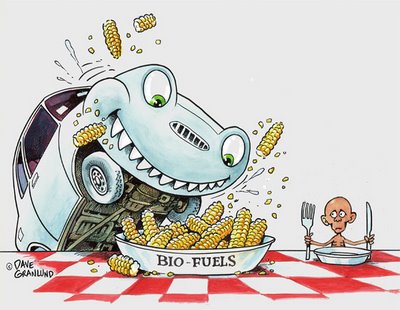1. Why did the German scientist decide to study the fruit flies at the larval stage?
2.How does the mother fly activate the control genes?
3. What is the role of control genes?
4.Which of the two species is closer to humans?
1.They did this in order to watch how they developed, although it was harder to study them because they were crawling on the food all the time. All sow, to observe which chemical message the mother left on the eggs.
2. The mother leaves on the eggs different chemical messages, that indicates which part of the egg will become the head and which will become the tail.
3. The "control gene's" role is to tell the cells of the body which organs and structures they should become, and when.
4. Actually, how the control gene works in both species is the same as in the human been. But the zebra fish's body plans are similar to humans.
Friday, August 9, 2013
Thursday, August 8, 2013
Thinking about Biofuels
In the last weeks, we have been studing the pros and against biofuels. It has been a very constructiva assesment, and very interesting too. We have joined in pairs and each pair had a specific topic to expose to the class. I made partner with Mr. Ugarte and our topic was "Biofuel process of production". We choosed a video form the internet and exposed about the process. Our presentation was a little hard because of all the technical terms we needed to learn, but we failed in the volume of our voices. The other presentations were pretty good, they presented about the impact of producing biofuels on economy, what is the effect of producing biofuels on land used for food or cattle and biogas. We gained a lot of knowledge in our main topic and now we are able to have our own opinions and diiscuss about it.
Thursday, August 1, 2013
Biofuel process of production
Biofuel is
considered to be the most pure and the easiest available fuels on the planet. One
of the key features of biofuels is that they are better than other forms of
fuels like petrol or diesel that is manufactured by most of the big oil
manufacturing companies.
Ethanol comes from:
-Corn
-Barley Starchy Crops
-Sorghum
-Wood Pulp
-Corn
-Barley Starchy Crops
-Sorghum
Celulosic Material
-Citrus
Sweet Crops -Sugar Beets
-Sugar Cane
-Switch Grass Plant Material-Wood Pulp
 |
| Biofuel Process of production (www.esru.strath.ac.uk) |
The process
of manufacturing biofuel can be classified in the following stages.
Filtering:
In this process, waste vegetable oil is filtered to remove all the food
particles. This process generally involves warming up the liquid a little.
After warming up the liquid, it can be filtered with the use of coffee filter.
Removing of water: All the water contained in the residual gangue has to be removed which will make the reaction faster. The water can be easily removed by making the liquid boil at 100 degree C for sometime.
Titration: This process is carried out to determine the amount of lye that would be required. This process is the most crucial and the most important stage of biofuel manufacturing.
Preparation of sodium methoxide: In this process, methanol is mixed with sodium hydroxide to produce sodium methoxide. In most of the cases, the quantity of methanol used is generally 20 percent of waste vegetable oil.
Heating and mixing: The residue is heated in between 120 to 130 degree F after which it is mixed well. It should be remembered that process should be done carefully avoiding splashing of the liquid.
Settling and separation: After mixing the liquid, it has to be allowed to cool down. After the cooling process, the biofuel will be found floating at the top while the heavier glycerin would be found at the bottom. The glycerin can be easily separated by allowing it to drain out from the bottom. The person is left over with pure biofuel which can be used for various purposes.
Subscribe to:
Posts (Atom)

